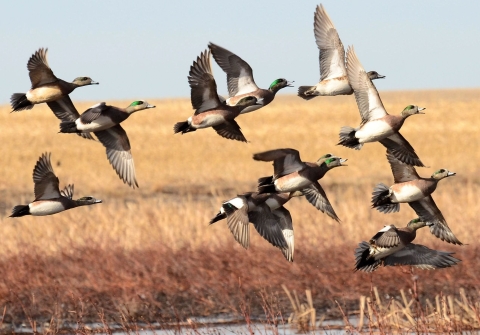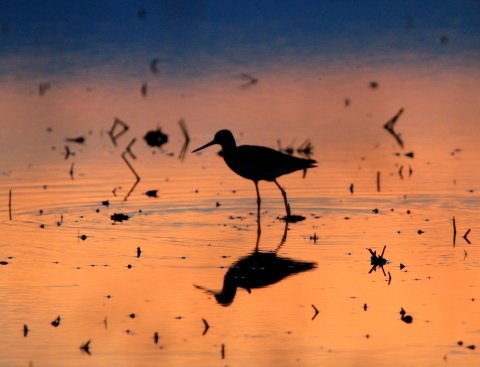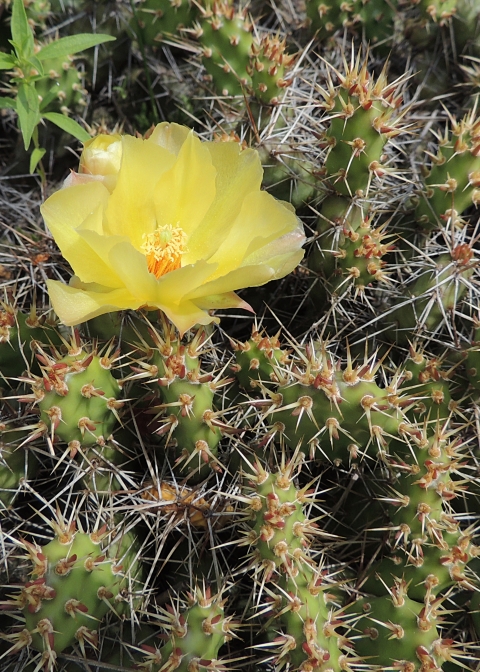Seasons of Wildlife
Spring migration in southwest Minnesota is a spectacle to behold. If you time it right, you can see thousands of Canada geese (Branta canadensis), snow geese (Anser caerulescens) and greater white-fronted geese (Anser albifrons) fill up the sky as they follow the snow lines north. The prairie potholes of the district also provide excellent stopover areas for 18 species of migratory waterfowl such as mallards (Anas platyrhynchos), northern shovelers (Spatula clypeata), northern pintails (Anas acuta), gadwall (Mareca strepera), wood ducks (Aix sponsa), ring-necked ducks (Aythya collaris) and hooded mergansers (Lophodytes cucullatus).
Drier springs mean lower water levels, which expose mudflats for migratory shorebirds. High quality wetlands can host more than 25 species of shorebirds as they rest and feed during their journey to their breeding grounds. Look for common species such as greater and lesser yellowlegs (Tringa melanoleuca and T. flavipes), least sandpipers (Calidris minutilla), short and long-billed dowitchers (Limnodromus griseus and L. Scolopaceus) and spotted sandpipers (Actitis macularius). Be on the lookout for rarities such as black-necked stilts (Himantopus mexicanus) and American avocets (Recurvirostra americana).
Spring is also an excellent time to look for neotropic migrants, including warblers, thrushes, swallows, vireos, hummingbirds, cuckoos and tanagers.
Summer is the best time to explore the prairies for grassland birds. Listen for the melodic tinkling of the bobolink (Dolichonyx oryzivorus) and the buzzy song of the grasshopper sparrow (Ammodramus savannarum). Henslow’s sparrows (Ammodramus henslowii) have a softer song and can be hard to find; look for them in native prairies that may be in need of a burn. Meadowlarks are a common sight in southwest Minnesota and frequent pastures and prairies. While out wandering, you may get lucky and come across a brood of gray partridge (Perdix perdix).
Wetlands are alive with sound during the summer months. Listen for the rattle of the marsh wren (Cistothorus palustris), the welcoming song of red-winged blackbirds(Agelaius phoeniceus) and the whinny of the sora rails (Porzana carolina). Summertime is also a great time to look for newly hatched ducklings. You might even catch a glimpse of trumpeter swan cygnets (Cygnus buccinator), a once rare occurrence in Minnesota.
Fall migration seems to take twice as long as spring migration, but it’s no less exciting. Waterfowl are once again plentiful. Shorebirds forage in shallow waters en masse, searching for tiny invertebrates to snack on.
Some species take extra effort to look for but are worth the time. Walking the prairie edges near sedge meadows and open wetlands may produce LeConte’s and Nelson’s sparrows (Ammospiza leconteii and A. nelsoni). If you’re super lucky, you might even flush a migrating yellow rail (Coturnicops noveboracensis) or short-eared owl (Asio flammeus).
Fall in southwest Minnesota is popular amongst hunters. Upland game birds, especially pheasants (Phasianus colchicus), are numerous. Gray partridge are a little harder to come by, but still present. White-tailed deer (Odocoileus virginianus) use prairies and wetlands for cover and can be seen regularly.
The winter months are an excellent time to look for northern specialists such as common redpolls (Acanthis flammea), snow buntings (Plectrophenax nivalis), Lapland longspurs (Calcarius lapponicus), American tree sparrows (Spizelloides arborea), dark-eyed juncos (Junco hyemalis), northern shrikes (Lanius borealis), rough-legged hawks (Buteo lagopus) and snowy owls (Bubo scandiacus). Resident wildlife such as white-tailed deer, wild turkeys (Meleagris gallopavo), bald eagles (Haliaeetus leucocephalus) and ring-necked pheasants can occasionally be spotted on waterfowl production areas and national wildlife refuges within the district.
Featured Species
The prairie pothole region of the district is an important rest area for migratory waterfowl. More than 18 species of duck and five species of geese use the district wetlands to stop and refuel for their journey north. Marsh ecosystems also provide important habitat for birds such as trumpeter swans, American bitterns (Botaurus stellaris), sora rails, Virginia rails (Rallus limicola), marsh wrens and black-crowned night-herons (Nycticorax nycticorax). Native and reconstructed prairies provide habitat for breeding grassland birds such as bobolinks, Henslow’s sparrows, grasshopper sparrows and western meadowlarks (Strunella neglecta).
Not only are district lands used as resting areas for migratory birds, they also provide habitat for resident wildlife. Wild turkeys, white-tailed deer, red foxes (Vulpes vulpes), coyotes (Canis latrans) and bald eagles are year round residents that you may encounter at any time on the district. Though rare, be on the lookout for black-tailed jack rabbits (Lepus californicus) and American badgers (Taxidea taxus), especially in the western part of the district.
Prairie streams of southwest Minnesota provide refuge for the Federally endangered Topeka shiner (Notropis topeka).
Through a Cooperative Recovery Initiative, Windom Wetland Management District, and partners, have worked to restore off-channel habitat for the Topeka shiner. These restored areas also provide habitat for more than 30 species of non-game fishes, including the State threatened plains topminnow (Fundulus sciadicus).
Floral Resources
Not only is the district home to hundreds of species of native grasses and forbs, the district is also host to several State and Federally threatened and endangered plants.
Small white lady's slippers (Cypripedium candidum) are rapidly declining and can only be found on a few waterfowl production areas in the district. Their tiny white flowers are only the size of a quarter and are hard to spot. Look for them in moist prairies, sedge meadows, and calcareous fens. The small white lady's slipper is a species of concern in Minnesota.
Ephemeral pools in the western part of the district are host to rare plants such as the State endangered hairy water clover (Marsilea vestita) and State threatened water hyssop (Bacopa rotundifolia). State threatened blue mud plantain (Heteranthera limosa) can be found in moist habitats such as ponds, lakes, and ditches. A few populations exist in the far western counties of the district.
Western prairie fringed orchids (Platanthera praeclara) are found in only a few counties in the district and is listed as Federally threatened and State endangered. They can be found in moist prairies and calcareous meadows. Look for showy white flowers in mid-July.
The prairie bush clover (Lespedeza leptostachya)is a Federally and State threatened species found in only a few areas of the district. They bloom in late July-early August and prefer dry prairies.
Cacti in Minnesota?? Did you know that Minnesota is home to three species of cactus? Two species of prickly pear occur on the district and can be found in the far western counties.
Brittle prickly pear (Opuntia fragilis) has smaller pads and spines than the plains prickly pear (Opuntia macrorhiza) but is no less painful to touch. Plains prickly pear is a special of concern in Minnesota.
Their large yellow flowers are a welcome sight in rocky outcroppings. They bloom late May-early July.


